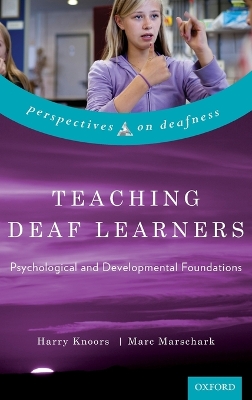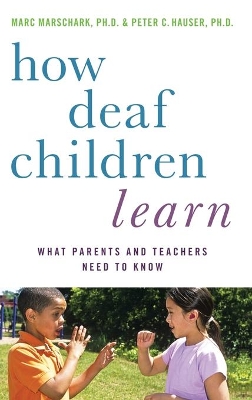Perspectives on Deafness
2 total works
Teaching Deaf Learners: Psychological and Developmental Foundations explores how deaf students (children and adolescents) learn and the conditions that support their reaching their full cognitive potential - or not. Beginning with an introduction to teaching and learning of both deaf and hearing students, Knoors and Marschark take an ecological approach to deaf education, emphasizing the need to take into account characteristics of learners and of the
educational context. Building on the evidence base with respect to developmental and psychological factors in teaching on learning, they describe characteristics of deaf learners which indicate that teaching deaf learners is not, or should not, be the same as teaching hearing learners. In this volume, Knoors and
Marschark will explore factors that influence the teaching of deaf learners, including their language proficiencies, literacy and numeracy skills, cognitive abilities, and social-emotional factors. These issues are addressed in separate chapters, with a focus on the importance to all of them of communication and language. Separate chapters are devoted to the promise of multimedia enhanced education and the possible influences of contextual aspects of the classroom and the school on the learning
of deaf students. The book concludes by pointing out the importance of appropriate education of teachers of deaf learners given the increasing diversity of those students and the contexts in which they are educated. It bridges the gap between research and practice in teaching, and outlines ways to
improve teacher education.
educational context. Building on the evidence base with respect to developmental and psychological factors in teaching on learning, they describe characteristics of deaf learners which indicate that teaching deaf learners is not, or should not, be the same as teaching hearing learners. In this volume, Knoors and
Marschark will explore factors that influence the teaching of deaf learners, including their language proficiencies, literacy and numeracy skills, cognitive abilities, and social-emotional factors. These issues are addressed in separate chapters, with a focus on the importance to all of them of communication and language. Separate chapters are devoted to the promise of multimedia enhanced education and the possible influences of contextual aspects of the classroom and the school on the learning
of deaf students. The book concludes by pointing out the importance of appropriate education of teachers of deaf learners given the increasing diversity of those students and the contexts in which they are educated. It bridges the gap between research and practice in teaching, and outlines ways to
improve teacher education.
In this invaluable guide, renowned authorities Marc Marschark and Peter Hauser highlight important new advances in scientific and educational research that can help parents and teachers of students with significant hearing loss. The authors stress that deaf children have strengths and needs that are sometimes dramatically different from those who can hear. Consequently, if deaf students are to have full academic access and optimal educational outcomes, it is
essential that parents and teachers learn to recognize these differences and adjust their teaching methods to them. Marschark and Hauser explain how the fruits of research conducted over the last several years can markedly improve educational practices at home and in the classroom, and they offer innovative
strategies that parents and teachers can use to promote learning in their children. The result is a lively, accessible volume that sheds light on what it means to be a deaf learner and that provides a wealth of advice on how we can best support their language development, social skills, and academic success.
essential that parents and teachers learn to recognize these differences and adjust their teaching methods to them. Marschark and Hauser explain how the fruits of research conducted over the last several years can markedly improve educational practices at home and in the classroom, and they offer innovative
strategies that parents and teachers can use to promote learning in their children. The result is a lively, accessible volume that sheds light on what it means to be a deaf learner and that provides a wealth of advice on how we can best support their language development, social skills, and academic success.

